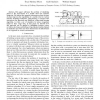93 search results - page 6 / 19 » Accurate mobile robot localization in indoor environments us... |
IJRR
2002
13 years 6 months ago
2002
A key component of a mobile robot system is the ability to localize itself accurately and, simultaneously, to build a map of the environment. Most of the existing algorithms are b...
ICRA
2010
IEEE
13 years 5 months ago
2010
IEEE
— In the last decades, tremendous progress has been made in the field of autonomous indoor navigation for mobile robots. However, these approaches assume the structural part of ...
ISER
2004
Springer
14 years 12 days ago
2004
Springer
This article present results for building accurate 3-D maps of urban environments with a mobile Segway RMP. The goal of this project is to use robotic systems to rapidly acquire 3-...
ICRA
2005
IEEE
14 years 19 days ago
2005
IEEE
— This paper addresses the problem of classifying places in the environment of a mobile robot into semantic categories. We believe that semantic information about the type of pla...
ML
1998
ACM
13 years 6 months ago
1998
ACM
To operate successfully in indoor environments, mobile robots must be able to localize themselves. Most current localization algorithms lack flexibility, autonomy, and often optim...

